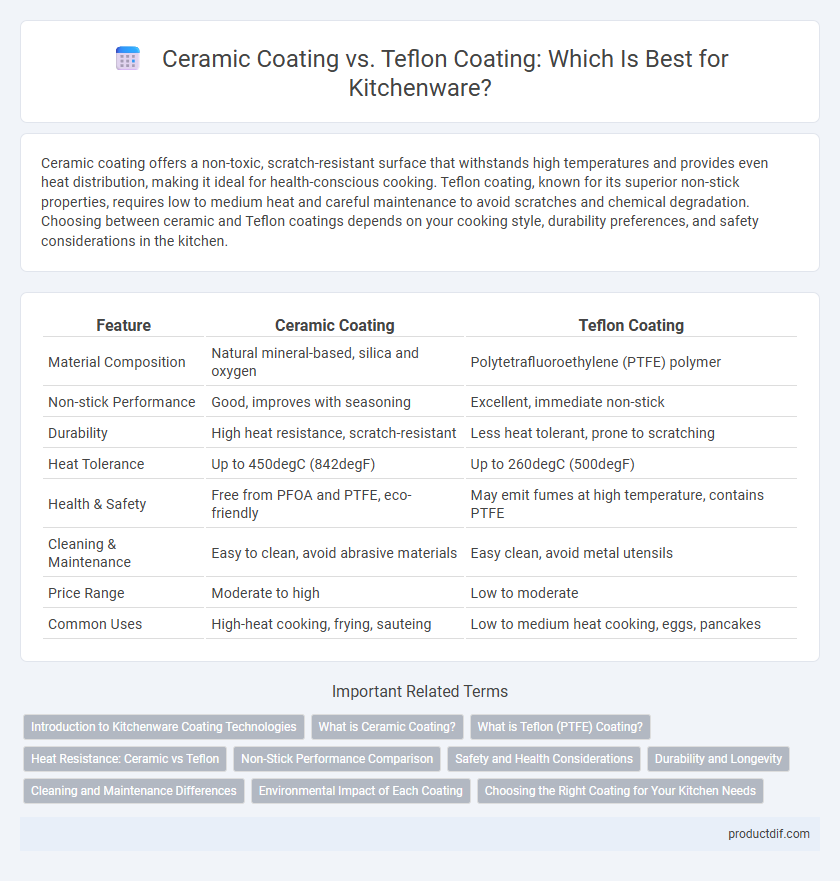Ceramic coating offers a non-toxic, scratch-resistant surface that withstands high temperatures and provides even heat distribution, making it ideal for health-conscious cooking. Teflon coating, known for its superior non-stick properties, requires low to medium heat and careful maintenance to avoid scratches and chemical degradation. Choosing between ceramic and Teflon coatings depends on your cooking style, durability preferences, and safety considerations in the kitchen.
Table of Comparison
| Feature | Ceramic Coating | Teflon Coating |
|---|---|---|
| Material Composition | Natural mineral-based, silica and oxygen | Polytetrafluoroethylene (PTFE) polymer |
| Non-stick Performance | Good, improves with seasoning | Excellent, immediate non-stick |
| Durability | High heat resistance, scratch-resistant | Less heat tolerant, prone to scratching |
| Heat Tolerance | Up to 450degC (842degF) | Up to 260degC (500degF) |
| Health & Safety | Free from PFOA and PTFE, eco-friendly | May emit fumes at high temperature, contains PTFE |
| Cleaning & Maintenance | Easy to clean, avoid abrasive materials | Easy clean, avoid metal utensils |
| Price Range | Moderate to high | Low to moderate |
| Common Uses | High-heat cooking, frying, sauteing | Low to medium heat cooking, eggs, pancakes |
Introduction to Kitchenware Coating Technologies
Kitchenware coating technologies primarily include ceramic and Teflon coatings, each offering unique non-stick properties and durability benefits. Ceramic coatings are made from inorganic materials that provide a chemical-free, heat-resistant surface ideal for high-temperature cooking. Teflon coatings consist of polytetrafluoroethylene (PTFE) and excel in reducing food adhesion with excellent glide performance but may degrade at temperatures above 500degF.
What is Ceramic Coating?
Ceramic coating is a non-stick surface made from inorganic materials, primarily silica, that forms a hard, durable layer resistant to scratches, high heat, and chemical damage. It provides a natural, toxin-free cooking experience by eliminating the need for synthetic chemicals commonly found in traditional non-stick coatings like Teflon. Ceramic coatings are prized for their excellent heat distribution and easy cleanup, making them a popular choice in modern kitchenware.
What is Teflon (PTFE) Coating?
Teflon coating, made from polytetrafluoroethylene (PTFE), is a synthetic fluoropolymer known for its non-stick properties and chemical resistance, making it a popular choice in kitchenware such as frying pans and baking sheets. It provides smooth surfaces that reduce food adhesion, ensuring easy cooking and cleaning while withstanding temperatures up to 260degC (500degF). PTFE-coated cookware offers durability and safety when used properly, though overheating can degrade the coating and release harmful fumes.
Heat Resistance: Ceramic vs Teflon
Ceramic coatings in kitchenware offer superior heat resistance, typically withstanding temperatures up to 450degF (232degC) without degrading or releasing harmful fumes, making them ideal for high-heat cooking methods. Teflon coatings generally have a lower heat tolerance, around 500degF (260degC), but exposure above 500degF can cause the non-stick surface to deteriorate and emit toxic fumes. Choosing ceramic-coated cookware ensures better durability and safety during high-temperature cooking compared to Teflon-coated options.
Non-Stick Performance Comparison
Ceramic coating offers superior heat resistance and maintains non-stick properties without releasing harmful fumes, making it ideal for high-temperature cooking. Teflon coating provides excellent non-stick performance at lower temperatures but degrades faster when exposed to overheating or metal utensils. For long-lasting durability and healthier cooking, ceramic coatings generally outperform Teflon in maintaining non-stick effectiveness over time.
Safety and Health Considerations
Ceramic coating offers a non-toxic, chemical-free surface that resists high temperatures without releasing harmful fumes, making it a safer option for health-conscious users compared to Teflon. Teflon coatings, while effective in non-stick performance, can release toxic fumes containing perfluorooctanoic acid (PFOA) when overheated beyond 500degF, posing respiratory risks. Choosing ceramic-coated cookware reduces exposure to potentially hazardous substances and supports safer cooking environments.
Durability and Longevity
Ceramic coatings offer superior durability compared to Teflon, resisting scratches and high temperatures up to 850degF without degrading. Teflon coatings, while providing excellent non-stick properties, typically begin to deteriorate at around 500degF, reducing their lifespan with regular use. The longevity of ceramic-coated cookware often surpasses Teflon by maintaining performance and surface integrity for several years under normal cooking conditions.
Cleaning and Maintenance Differences
Ceramic coatings offer a non-stick surface that is scratch-resistant and can be cleaned easily with mild soap and water, requiring minimal effort to maintain its smooth finish. Teflon coatings, while also non-stick, demand careful handling to avoid scratches and damage, and often require gentle cleaning with non-abrasive sponges to preserve the coating. Over time, ceramic-coated cookware tends to retain its non-stick properties longer, reducing the frequency of re-coating compared to Teflon surfaces which may degrade faster under harsh cleaning conditions.
Environmental Impact of Each Coating
Ceramic coating is made from natural minerals and is free from harmful chemicals like PTFE and PFOA, making it more environmentally friendly due to its non-toxic composition and biodegradability. Teflon coating, which contains PTFE, can release toxic fumes if overheated and the manufacturing process involves harmful chemicals that pose environmental risks during production and disposal. Ceramic-coated cookware often has a longer lifespan and better recyclability, reducing waste compared to Teflon-coated pans that tend to degrade faster and contribute to landfill pollution.
Choosing the Right Coating for Your Kitchen Needs
Ceramic coating offers a non-toxic, scratch-resistant surface ideal for high-heat cooking and durability, while Teflon coating provides superior non-stick capabilities and easy food release, best suited for low to medium heat. Consider your cooking style and maintenance preferences: ceramic is more eco-friendly and chemically inert, whereas Teflon requires gentler handling to avoid scratching and potential chemical degradation. Selecting the right coating depends on whether you prioritize heat tolerance and health safety or convenience and effortless cleaning in your kitchenware.
Ceramic Coating vs Teflon Coating Infographic

 productdif.com
productdif.com